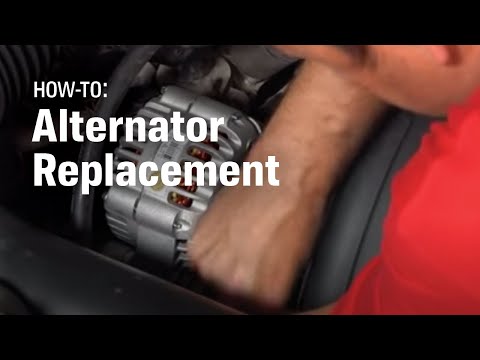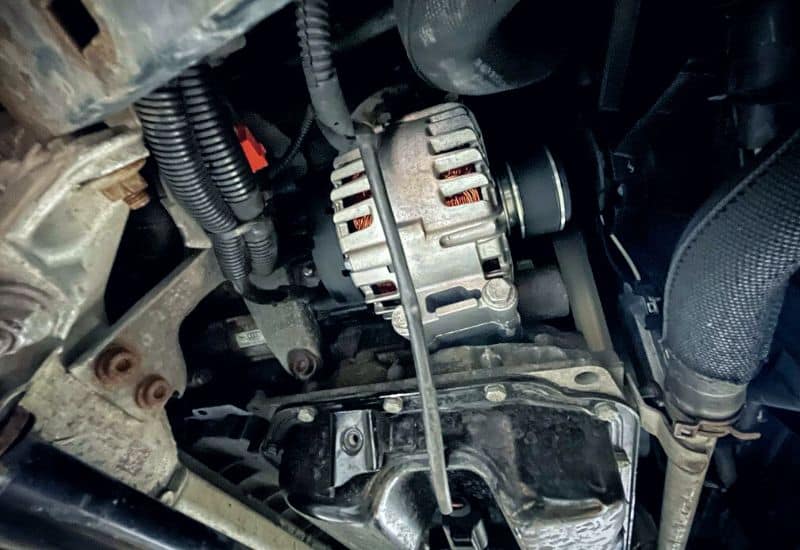
Is your car’s battery’s charge level low, but it still tests as good? If so, chances are good that your alternator is either dead or dying. So why is your alternator not charging your battery?
The truth is that alternators have a limited lifespan, and they can die with age. Though things like bad fuses, loose wires, a loose serpentine belt, or an ECU problem cab accelerate an alternator’s early demise.
The good news is that if it truly is just the alternator coming to the end of its life, the easiest fix is simply to replace it. This is something you can do yourself if you’re mechanically handy. Though most mechanics will charge you less than $500 to replace it for you if you’re short on time.
The problem is that not all alternator problems are limited to just the alternator. So, we’re going to have to take a a closer look at some of the more common reasons why an alternator may fail to charge your car’s battery, and how you can fix them.
Now, it’s worth mentioning that while some of these issues might require you to replace the alternator, there are a few simple fixes that could potentially save save you from a major repair bill. So, let’s roll up our sleeves and get to the bottom of this, shall we?
How Does an Alternator Work?
Your car’s alternator uses some of the mechanical energy produced by the car’s engine to create electricity which is stored for use in the 12 Volt battery. Any time an alternator has a problem, the battery’s charge level will suffer.
If it seems like your battery isn’t holding a charge, but it still tests as being good, then it’s likely that your alternator is dead or dying.
Diagnosing an Alternator That Won’t Charge
Diagnosing an alternator that won’t charge starts with testing the battery and eliminating it as a problem.
You can do this yourself by connecting a multimeter or voltmeter to the battery. If it gives you a reading in the neighborhood of 12.6 Volts, then your battery isn’t the problem.
You can then connect the meter to the terminals on the alternator to see if it will give you a reading of around 12.6 volts.
If you don’t have a multimeter at home, most auto parts stores, automotive service centers, and battery stores will test your car battery for free. They can also bench-test your alternator for free.
How Do You Tell If Its Your Alternator Or Your Battery?
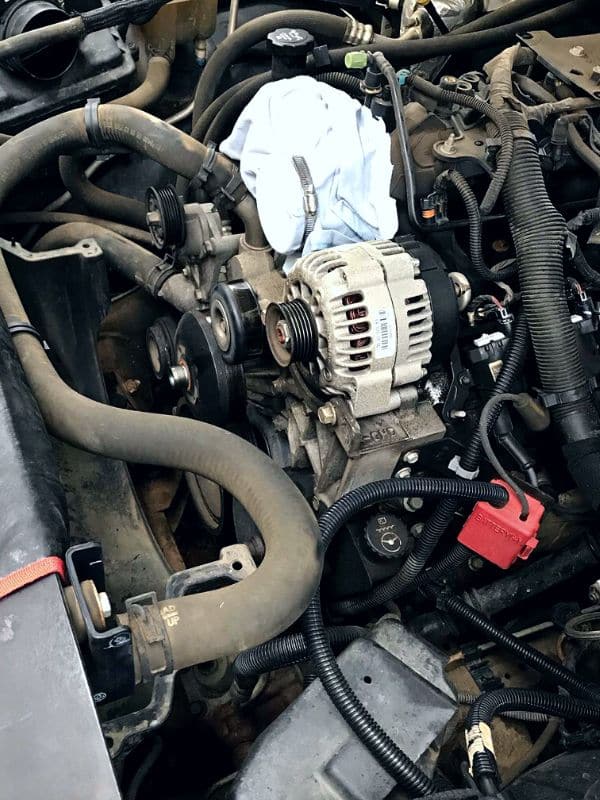
The symptoms of a bad alternator and a bad battery are very similar, though there are a few distinct differences. You most likely have a bad alternator if:
The alternator might have worn due to age and natural wear and tear, other things can accelerate or mask the true reason why the alternator not charging.
It can help to inspect or at least eliminate some of these other possibilities before committing yourself to replace what might still be a functional alternator.
10 Possible Reasons Your Alternator Isn’t Charging Your Car’s Battery
When an alternator not charging the car’s battery it’s sometimes limited to the alternator coming to the end of its natural life.
Though other potential problems could have accelerated the process.
If you don’t find them and fix them, a replacement alternator will suffer the same abuse and an eventually shortened lifespan.
The alternator’s inability to charge your car’s battery can be attributed to several reasons, and some of the most typical causes include:
1: You Have Severe Corrosion on the Battery Terminals
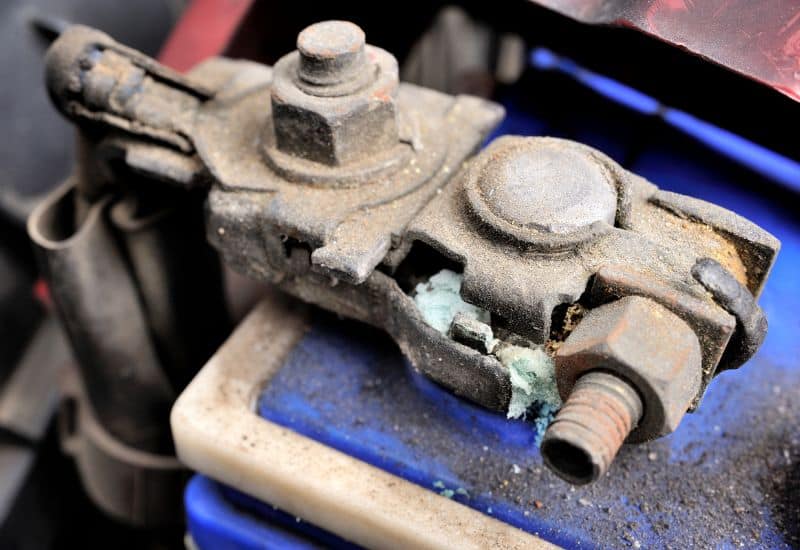
The process of charging and discharging a 12 Volt lead-acid battery can lead to corrosion on the battery terminals.
If it’s allowed to build up unchecked the corrosion itself can get in the way of the efficient transfer of electricity from the alternator intended to be stored in the battery.
This typically manifests as a powdery-looking white, gray, or even green substance on the positive red terminal of the car battery. This is arguably the easiest fix for an alternator that’s not charging.
How to Clean Corroded Battery Terminals
Cleaning corroded battery terminals is very easy, and often only takes an old toothbrush or wire brush, some baking soda, a little bit of water, and some clean shop rags. You can then clean the terminals using the following steps.
2: Your Car Has a Bad Battery
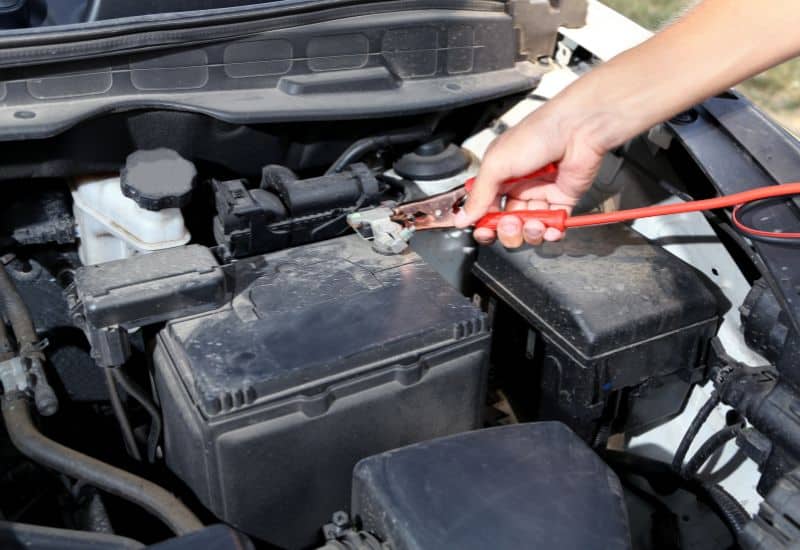
Car batteries have a limited lifespan of three to five years. Once the internal components of a lead-acid battery start to degrade even the best alternator in the world won’t be able to sufficiently charge it.
Signs of a Bad Car Battery
If the battery is the reason your alternator’s not charging you might notice the following signs.
How to Test for a Bad Battery
The easiest way to test a car battery is to hook it up to a multimeter or a voltmeter. If the battery is good, you should get a reading of around 12.6 Volts when it’s sitting. If you’re getting a reading below 10 Volts, then the battery is likely the reason why the alternator’s not charging.
If you don’t have a meter, most auto parts stores and battery shops will test your car battery for free.
When to Replace the Car Battery
The signs of a bad battery and a bad alternator are very similar. So you want to make sure that the battery is indeed bad before replacing it, or moving on to troubleshooting and/or replacing the alternator.
If you disconnect the battery while the car is running, and it stays running for more than 15 to 20 minutes, then the alternator is likely good and the battery is bad.
Before driving to an auto parts store, you want to make sure that you can disconnect the positive terminal from the battery. If the connection hardware on the positive wire is also bad, you might need to have the entire wire replaced. This is not something you can easily do in an auto parts store’s parking lot!
3: Your Alternator Has Bad Diodes
Within the electric components inside a car’s alternator, you’ll find a series of diodes. It’s possible for overheating problems, overcharging issues, time, and stress to gradually damage alternator diodes. Your alternator can lose one or two with only a minimal change in performance. Though over time, the diodes die, and the alternator is rendered inert.
Signs of an Alternator with Bad Diodes
If your alternator has one or more bad diodes you might notice the following things:
How to Test If an Alternator Has Bad Diodes
You can use a multimeter to test the individual diodes inside your alternator. If you don’t get a reading, the diode is burned out or damaged.
If you can’t easily access the diodes or you don’t have a multimeter, most auto parts stores will test an alternator for free.
Though you’ll likely have to take the alternator out for them to perform this type of bench test.
How to Fix an Alternator with Bad Diodes
If your alternator has bad diodes, you’ll either have to have it rebuilt or replaced. These days the more economical option is simply to replace the alternator altogether.
It’s generally faster and usually costs less compared to having a professional mechanic rebuild an old alternator.
4: A Worn-Out Alternator
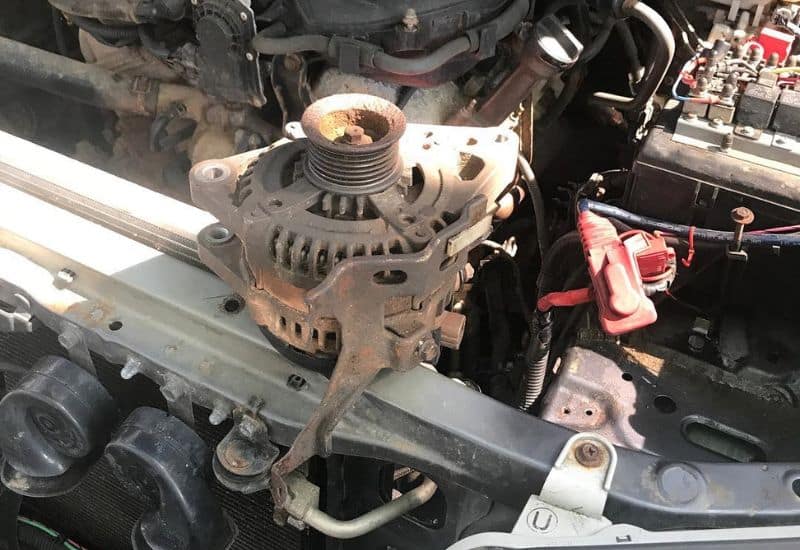
The average lifespan of an alternator is around 7 to 10 years. If your car is in this age range, the battery tests as good, and you’ve never had any other electrical problems, it might just be that your car’s alternator has simply come to the end of its life, resulting in an inability to charge the battery.
It’s worth checking online for reviews or recalls for your make and model related to premature alternator problems. Especially if your alternator started not charging before 7 years old.
There are a few things that can accelerate the natural death of an alternator that isn’t specifically linked to other faults in the car.
If you’ve accidentally connected jumper cables to the wrong battery terminals when jumping your car or someone else’s it can stress and damage the alternator.
If you’ve used jumper cables to charge an accessory battery, it can stress the alternator leading to an early death.
Can I Replace an Alternator Myself?
If you have a modest amount of mechanical skills, you can save yourself a lot of money by replacing your own alternator.
The cost of a replacement alternator ranges from $125 to $250 depending on the size and model.
The cost of having a mechanic replace your alternator ranges from $225 to $400.
It generally takes around 2 to 3 hours to replace your own alternator. When you consider the cost savings of $150 to do it yourself, even a three-hour repair is like paying yourself $50 an hour!
Once you’ve sourced the correct replacement alternator, you can replace the worn-out one with the following steps.
5: Your Alternator Might Have a Blown Fuse
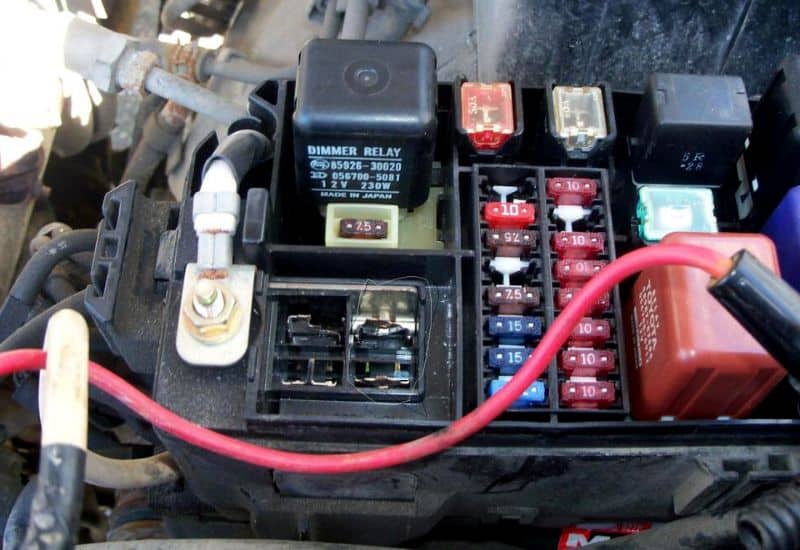
A lot of modern vehicles have two fuses connecting to the alternator. If one or both of them burns out, it can result in the alternator not charging the battery.
So, before you dive headfirst into placing your alternator on the assumption that the alternator burned out, you need to put in the due diligence to check the related fuses.
Fixing Bad Alternator Fuses
If you do find that one or both alternator fuses are burned out, you can replace them, and chances are good that the alternator will start charging again.
Just bear in mind that fuses are meant to be protective measures to protect the alternator from damage due to short, circuited wiring or other electrical faults.
If you can think of an obvious reason why the fuses might have blown, such as accidentally jumping the car with the jumper cables attached to the wrong terminals or trying to recharge a second 12 Volt battery via jumper cables, then you can let your guard down.
Otherwise, you should assume that burned-out alternator fuses are a symptom of a more serious issue in the car’s electrical system. You’ll need to dig deeper to ferret out the underlying cause of why the alternators not charging.
6: Your Alternator Has a Wiring Problem
Alternators typically rely on three wires to function properly. If there’s a problem with one of these wires it can lead to the alternator not charging and/or cause the blown fuses you might have found earlier in your troubleshooting efforts.
The first wire needed to keep the alternator running is known as the “Excitor.” It’s connected to the L terminal of an alternator itself and serves as the voltage regulator.
If it’s loose or the connection has broken free, the alternator won’t be able to start running.
There’s also an ignition wire that activates the field coils. If this wire is disconnected or compromised in some way it will cause the alternator to not charge. This often results in the battery light turning on in the car’s dash.
The third alternator wire is connected directly to the battery and is responsible for charging it. If this wire has been disconnected or corroded any potential charge created by the alternator would be insufficient for charging the battery.
You should also note that while this three-wire setup for the alternator is the most common.
However, there are some vehicles with different variations, including four-wire alternators. So, make sure to check for your specific make and model online or in a repair guide.
Fixing Alternator Wiring Problems
Most alternator wiring problems are simply loose connections. This might be due to excessive engine vibration, corrosion or accidentally stretching a wire while working on something else in the engine bay.
The fix here is pretty straightforward. If you see signs of corrosion, you’ll need to remove the compromised section to wire. Then strip back another inch or so of freshly exposed wire and securely reconnect it.
If the wire itself has been damaged by a short circuit, or the protective coating has been accidentally damaged in the middle of the wire, the wisest choice is to completely replace it.
7: Your Car Has a Problem with the Belt
Most modern cars have a serpentine belt that snakes through the engine. It supplies power to a wide range of important components such as the alternator, the power steering pump, the air conditioning, and in some models even the car’s water pump.
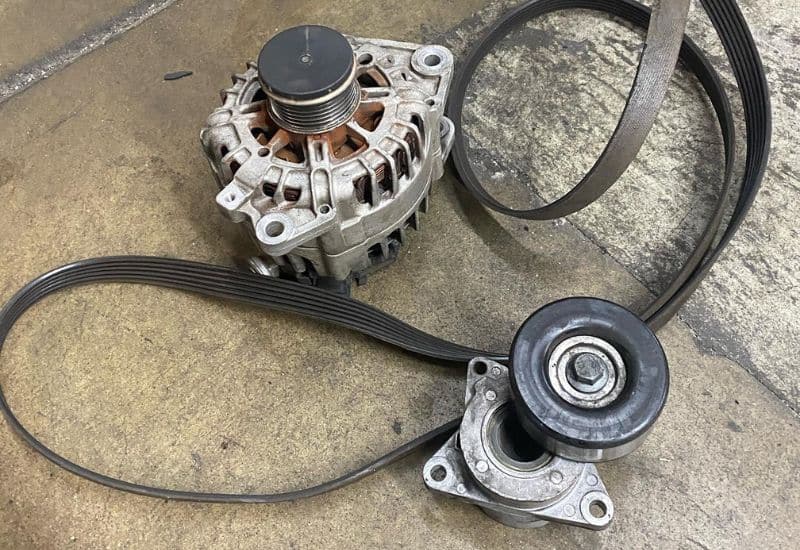
If the tension of the drive belt is too tight, it can cause excessive wear on the alternator, leading to premature burnout. On the other hand, if the belt is too loose, it can hinder the alternator’s ability to generate electricity, making it appear as if the alternator has failed to charge the car’s battery.
Symptoms of a Loose Serpentine Belt
If a loose serpentine belt is a reason your car’s alternator is not charging, you’ll be able to spot it relatively easily, in the troubles of other components. Common symptoms of a loose serpentine belt include:
How to Fix a Loose Serpentine Belt
While it’s possible for there to be an issue with one or more tensioners in the serpentine belt assembly, most loose serpentine belts are related to basic wear and tear that occurs with age.
Carefully inspect the belt. If you see signs of cracking, fraying, or the V-shaped “Teeth” on the underside of the belt have worn smooth, you’ll need to replace the serpentine belt.
If the serpentine belt itself seems to be in good repair, but you’ve been hearing a lot of squealing under the hood recently, then it might be a problem with the tensioner arm itself.
How to Replace a Serpentine Belt
If an old worn-out serpentine belt is the reason why your alternator’s not charging, you can replace it with the following steps.
Note: You make sure to have the replacement belt first, as well as a belt tensioner tool. Both of these can be found at most auto parts stores.
8: Your Car Has a Problem with the ECU
Most modern vehicles have an Engine Control Unit or ECU which acts as the brain of the engine. It plays a critical role in optimizing the performance of most of the car’s electrical components. While it’s rare, a problem with the ECU can, in some cases, can interfere with the alternator’s ability to charge the car’s battery, leading to the alternator’s failure to perform its intended function.
If you’ve checked over all the other possible reasons why the alternator’s not charging the battery and you’re still baffled. Then you can check the ECU via a code reader. You’re looking for any trouble codes related to the car’s electrical system.
How to Fix an ECU Problem
Most ECU problems need the diagnostic services of a mechanic to properly fix with confidence. The inspection itself will cost $150 to $300.
If the ECU simply needs to be reprogrammed, you can expect them to tack on another $350 to $700. If the ECU needs to be completely replaced the cost can be as high as $1,250 to $3,000.
9: There Was an Accidental Oil Spill on the Alternator
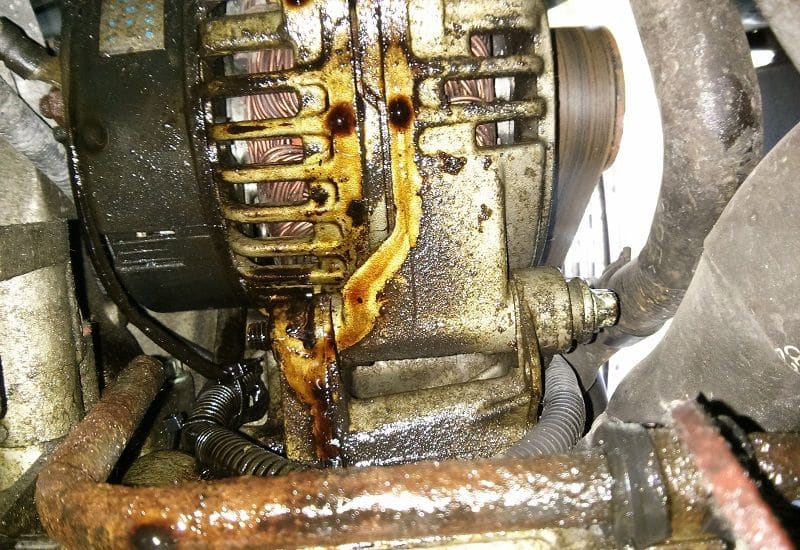
I know it sounds silly, but it’s easier than you think to accidentally spill a couple of drops off the end of an oil dipstick onto an alternator or spill a nasty blob when topping up your engine oil.
If those drips of errant oil end up getting into the internal workings of the alternator they can easily spread to the inner components. It’s also a common consequence of a cracked head that spills oil in the engine bay.
As time goes on, the oil can trap dust and other particulate matter which starts to clog up the alternator.
If the brushes that help produce electrical charge get badly clogged, it can adversely affect the alternator’s performance, ultimately leading to a decrease in the car battery’s charge level.
How to Safely Remove Oil from an Alternator
The easiest and safest way to remove oil from an alternator is to use an automotive electronics cleaner. You can usually find it at an auto parts store and it’s meant specifically for this job. It’s a much safer way to clean an accidental oil spill from an alternator than improvising with dish soap or brake cleaner!
10: There’s a Problem with the Voltage Regulator
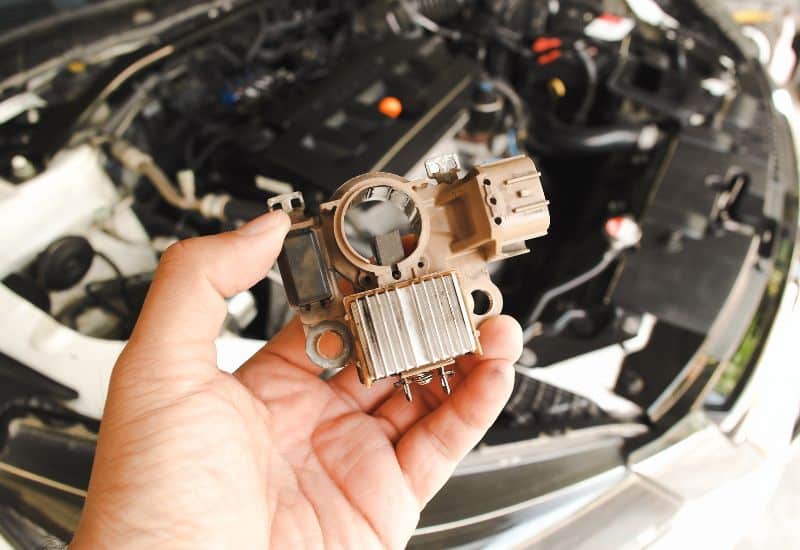
An alternator’s voltage regulator plays a critical role in accurately controlling the amount of electrical current flowing through the rotor’s field coils. This in turn affects the alternator’s voltage output. When there’s a fault in the voltage regulator it can allow too much current to pass to the battery.
Left unchecked a bad voltage regulator can damage the battery as well as the alternator. Not to mention the very serious risk of burning out or damaging sensitive electronics throughout the car.
Signs of a Bad Voltage Regulator
Overcharging is the most common early sign of a bad voltage regulator. This includes:
How to Fix a Bad Voltage Regulator
It is possible with some models to replace the voltage regulator or bypass it.
Of the two, replacement is the more preferable option, especially if you’re trying to do it yourself, as an improperly done bypass can leave you at high risk of damaging your battery by overcharging it.
Why Is My Car Battery Not Charging With A New Alternator?
If you went ahead and replaced the old alternator with a new one, only to find that the new alternator also isn’t charging the battery, then chances are there was/is still another lingering problem that caused the premature death of your previous alternator.
Though before you start digging around in the engine bay again, it’s best to make sure there isn’t an unknown problem wit parasitic drain in the car’s electrical system.
Sometimes a high-powered stereo system or a short circuit in one part of the car’s wiring can cause so much drain that it makes it hard for even a properly functioning alternator to charge the battery.
Common types of parasitic electrical drains can include:
Frequently Asked Questions
Is there a fuse for the alternator?
Most alternators have one or two fuses that you can find in the engine bay’s fuse box. This fuse can burn out if there is a short circuit in the alternator wires or you recently tried to jump-start the car and either your vehicle or the other vehicle had the leads connecting improperly.
Can I test my alternator without removing it?
If you have a multimeter or a voltmeter you can test your alternator without having to remove it. Once connected to the terminals, a properly functioning alternator should give a reading of around 12.6 Volts. Most auto parts stores will test alternators for free. Though this type of professional bench testing often requires removing the alternator itself.
How can I test my alternator without a meter?
The improvised way to test an alternator without a meter starts with revving the engine and holding it steady at 2,000 RMS. Then turn on as many of the car’s electrical accessories as possible. Then turn your car’s radio to the lowest AM station. Listen closely to the sound coming from the speakers for a whining or buzzing sound, which can indicate a problem with the alternator itself.
How long will a car run with a faulty alternator?
If the alternator is going bad but not completely dead, the car might still run reasonably well for a few days or even a week. If the alternator is dead, but you know that you have a fully charged battery, then you have at best 20 to 30 minutes of drive time to get to an auto parts store or a mechanic.
Can I damage my alternator by jump-starting it wrong?
One of the more common ways that alternators are damaged into a premature death is by jump-starting with one set of leads on a car connected to the wrong terminals. This doesn’t necessarily kill the alternator or battery right away unless it’s done excessively. Instead, it accelerates the eventual death of the alternator.
Conclusion
When your car’s alternator is not charging the battery, the most likely issue is that the alternator itself has worn out, is dying, or is completely dead. Though you shouldn’t just jump to this conclusion, as there are plenty of things that can hamper the performance of a perfectly good alternator.
Start by checking the fuse(s) if it’s burnt out, you can replace it, and the alternator should start charging again. Though you need to determine what caused this robust fuse to burn out in the first place.
As long as you’re in the area, check the wires for the alternator to make sure they are all secure and in good order. If a wire is loose, you might be able to simply strip it back an inch and reconnect it securely. If a wire has shorted out or been damaged, you might need to completely replace it.
Next inspect the serpentine belt for signs of cracks, fraying, and looseness. If you’ve also been hearing a lot of squealing sounds, and the alternator reads as being good on a meter, then the best fix is to simply replace the serpentine belt itself.
If all else checks out good, then the last logical option for why your alternator’s not charging is a problem with the car’s ECU. This typically requires the diagnostics and intervention of a professional mechanic.

Written By
Jason Farrell
Jason Farrell is a certified master technician, the editor of Mechanic’s Diary in Pittsburgh, Pennsylvania. He is ASE (Automotive Service Excellence) certified and earned a Bachelor’s Degree in Automotive Technology from Pittsburg State University. With nearly 18 prior years of experience in the automotive field, he has extensive knowledge about Domestic, European, and other foreign makes and models of cars and light trucks. Jason’s experience working as a technician and service manager at dealerships, gave him the experience and know-how of most aspects of inspection, diagnosis, and repair from engine and drivability to electrical, HVAC, brakes, steering and suspension and everything in between.

